Located on the banks of the Douro river, Porto fascinated through its history ‘inevery tile’ and conquered the heart of far-away travellers with its cuisine and the friendliness of its people. Since over 200 years, Porto was already world famous for the fortified port wines made in the region. After Porto was declared European City of Culture in 2001, the inevitable tourism boom ensued, with boosts from their Historic Center being voted a UNESCO World Heritage Site along with the riverside bairro of Ribeira.
After arriving at Oporto airport and a quick check-in at the hotel, I started my first steps of discoveries walking around Porto’s waterfront known as the Ribeira, alongside couples of all ages, families and group of friends, traced the cobblestone streets with picture squesteep houses clustered up hills. Pedestrian friendly roads lead to hidden terraces, where I was mingling with locals and tourists who came to enjoy the warm rays of the sun while sipping on Douro Valley wines or a wide selection of Porto.
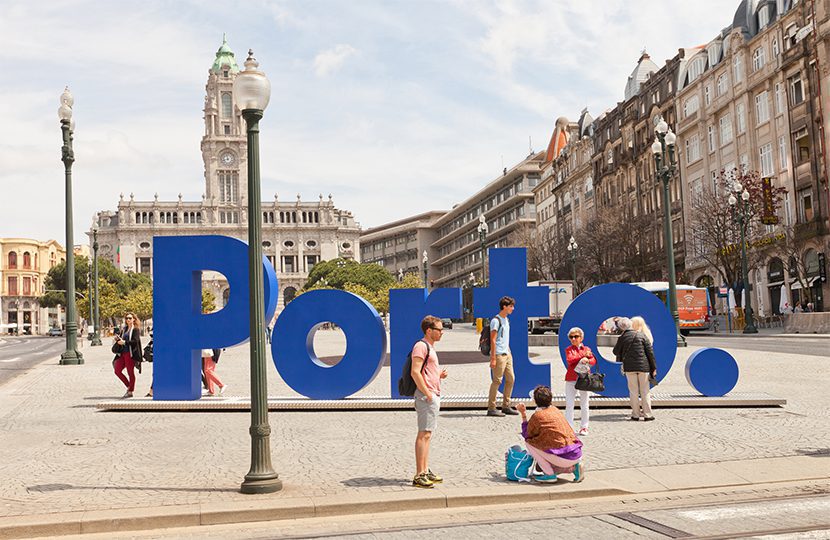
Porto in giant blue letters, the color of the infinite sky blessing the whole of Portugal
A couple of days are enough to see the main attractions here unless you are a gourmet connoisseur and plan to visit several port wine lodges at Vila Nova de Gaia, located just across the Rio Douro (River of Gold). The capital of the North, which the poet Luís de Camões once christened as ‘the eternal name of Portugal’, has experienced an artistic and creative renaissance in recent years.
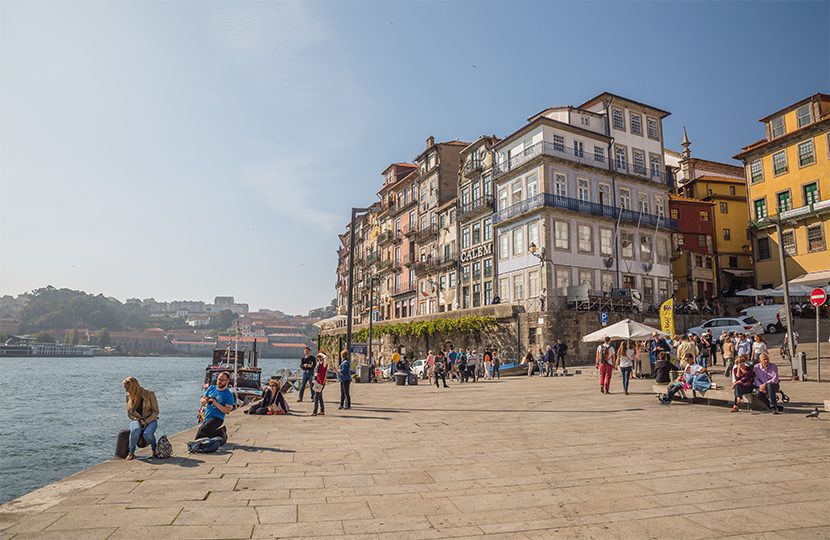
Tourists and locals are enjoying the sunshine along the Douro River
For eating and going out, I was spoiled with choices with new restaurants, cafes and bars opening up each year, along with an extensive selection of boutique hotels. Striking out for its innovative design, I decided to stay at Hotel Vincci, which was previously an iconic building popularly known as the ‘Fish Bag’ stands. The eclectic warehouse, which dates back to the 1930s and was built by the architect Januario Godinho, was transformed into a unique hotel managed by the hotel chain Vincci Hotels.
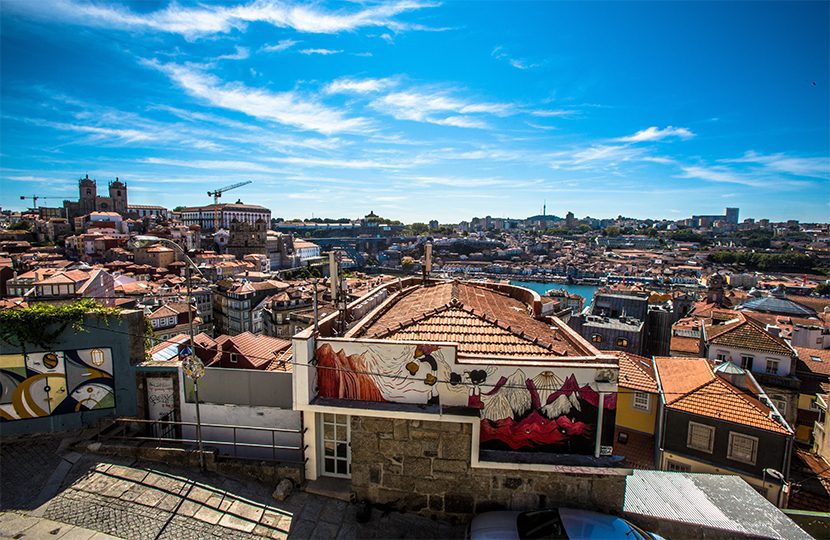
A view above Porto’s roofs shows the expanse of the revived city
This four-stars establishment practically maintained the original structure. Its façade features magnificent bas-reliefs that echo the lives of the city’s fishermen. The interior design concept of this 95-room property is based on an intricate Art Deco style that is reflected in the bright, expansive spaces. Facing the Douro river, the hotel offers guests aprivileged view of its course towards the Atlantic. The trendy rooftop lounge bar is not to be missed.
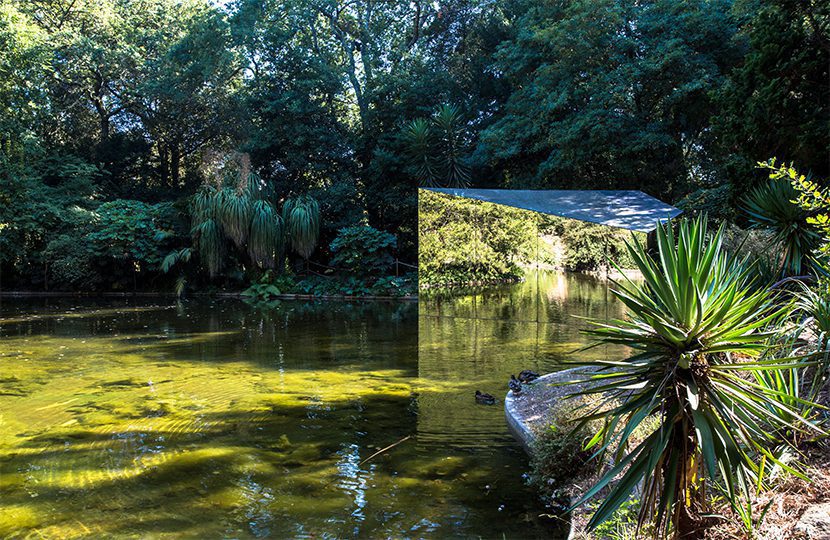
Artificial lake in the park of the Foundation Serralves with an art installation
Gentrification might have taken over this historical city with the old riverside back-alleys of modern Porto, along many streets and squares have been reconstructed and historic buildings restored to their former glory. After walking around the commercial centre and touring the cathedrals, I was looking forward to viewing two essential cultural attractions: the world-class Fundacao Serralves museum of contemporary art, designed by the native from Oporto Alvaro Siza Vieira and modern architecture Casa Musica, designed by Rem Koolhaas.
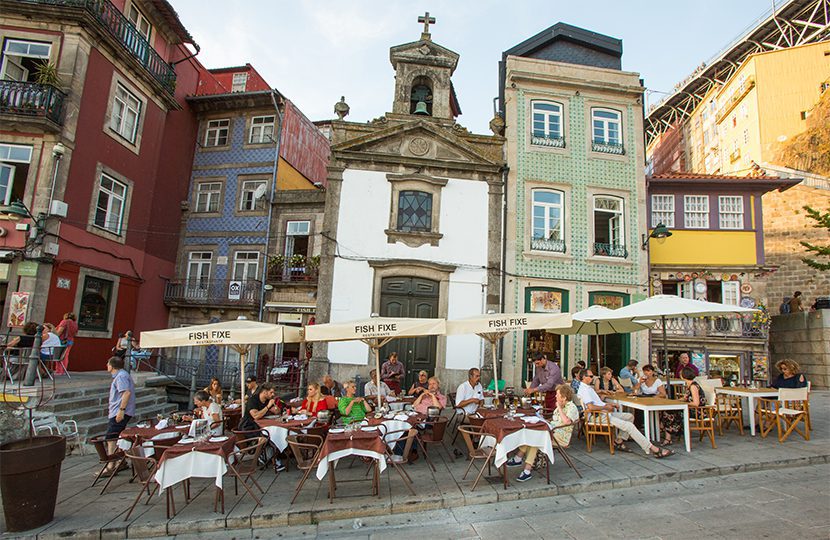
The terrace at Fish Fixe Portuguese restaurant
Fundacao Serralves has by far the best collection of contemporary art in Portugal. Permanent collections of fine works of art from the late 1960s to the present are showcased throughout the year, along with other exhibitions. The Museum of Contemporary Art (Museu de Arte Contemporânea) is an arrestingly minimalist, whitewashed space designed by world-renowned local architect Álvaro Siza Vieira. The Mansion, dating from 1925, is also worth visiting for its art deco architecture. Designed by Jose Marques da Silva, the Rene Lalique skylight with a neo-baroque chapel completely enveloped within the pink walls is inspiring.
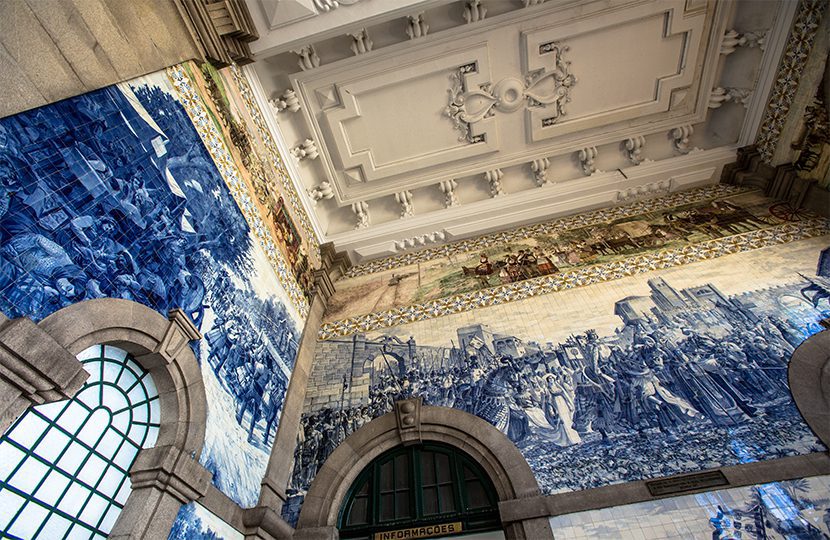
The blue tiled walls and ceilings at Porto train station
After the intense art-intake, I needed fresh air and took a walk in the picturesque 18-hectare Parque de Serralves. The proto-modernist park landscaping features lily ponds, rose gardens and formal fountains which adds a whimsical touch to the manicured French-style garden. The top-floor restaurant, a cherry-on-top moment, offers panoramic views of the whole estate and park.
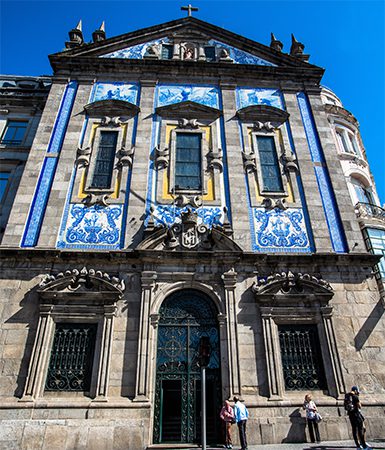
The front entrance of Congregados church in Porto
Time for lunch! An affair that is taken seriously in Oporto! To reach the other bank of Douro River I took an old tramway, then walked over the 6-meters above water bridge (Ponte Maria Pia) crossing to Vila Nova de Gaia, which is synonymous with Port wine trade, a riverfront area with dozens of company lodges and warehouses (called ‘caves’), with some in business for over three centuries. Long lines of cafes, bars and restaurants along with cruise boats docked along the esplanade are popular with tourists.
I found it convenient to visit the oldest Port house first – Taylor’s Port, established in 1692 and dedicated to the production of fine Port wines for the past 325 years. Regarded as the benchmark for Vintage Port, the initially family-owned firm pioneered the ‘LBV – late bottled vintage’ port, as the world leading producer.
I took a private Taylor’s tasting tour (starts at 12 €/adult) that includes one LBV glass from 2012 – Ruby Port from a single year, chosen for its high quality and bottled after ageing for four to six years in wood. I could finally learn the differences between a Ruby and a Tawny. I could also try their unique Extra Dry White Port.
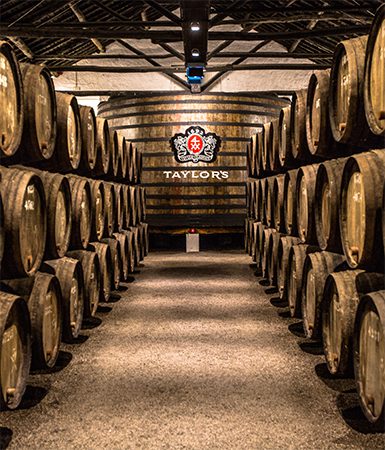
The precious wood casks at Taylor’s Port warehouse and showroom
Located next to The Yeatman, a luxury hotel opened in 2010 with a roll-call of A-list guests and always almost full, Taylor’s is amongst the wine producer & partners that sponsor individual rooms and suites featuring objects that provide an insight into each winery’s unique history. Time for a gastronomic lunch at Barão Fladgate restaurant, with its stunning hillside terrace offering a panoramic view of Gaia and the bridges over the Rio Douro. The food leans more towards the traditional Portuguese cuisine set in a comfortable and classy environment. Of course, a comprehensive choice of both wood-aged and Vintage Ports are listed in the menu. www.taylor.pt
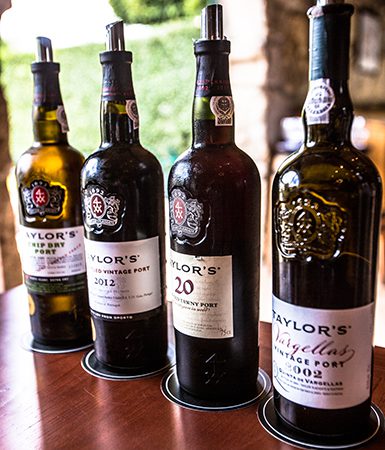
Taylor’s line-up during the port tasting
After lunch, I headed to a late afternoon guided tour (7,5 €/person) at Casa da Musica, a distinctively faceted spaceship-like form, which quickly became an icon of contemporary design. The all white concrete and glass building with its asymmetrical shape and innovative materials used by Rem Koolhaas and Ellen van Loon from architect bureau OMA had a significant impact on the once conservative inhabitants. The House of Music features two concert halls and one elevated shoebox-shaped Grand Auditorium with corrugated glass facades at both ends that can also serve as a dramatic backdrop for outdoor performances. Another smaller and intimate hall offers a flexible performance space with no fixed seating. Both halls are wrapped around by a winding series of rehearsal rooms, recording studios, a restaurant, terrace, multi-purpose bars, a VIP room and social spaces. The Purple Room is worth noting alongside The Orange Room. The A Música Toma Conta de Mim (The Music Takes Care of Me) project invites children, from 3 to 10 years old, to get immersed in the sensory room, interacting with each other and discovering musical creations away from their parents who can enjoy the concert in the main hall. www.casadamusica.com
After a quick refreshing stop back at the hotel, I headed out for dinner at Fish Fixe, a pleasant stroll away along the Ribeira. Located on a hilly street along the river, as the name implies, fish is the main staples and is highly acclaimed in this Porto fixture. Best seating is outdoors, allowing one to be part of the constant animations happening from the busy street while enjoying views of the Ponte de Infante and the Ponte D. Maria Pia (an unmistakable work of Gustave Eiffel and the first railway crossing over the Douro dating back to 1877).
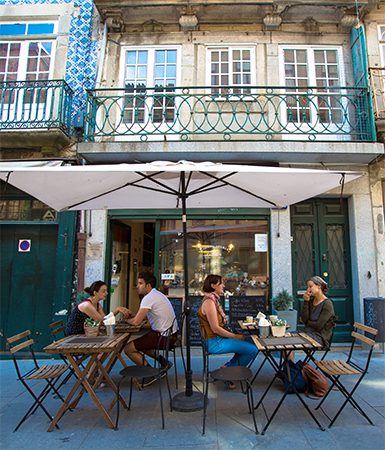
Simple enjoyments at a terrace cafe
Try their freshly caught sardines (Filetes de sardinha com arroz) or the roasted octopus (Polvo à lagareiro) tender as butter. Fish Fixe, Rua da Lada, 24 – Porto www.fishfixe.pt
For every lunch and dinner during the stay, my culinary mission was to discover a different Portuguese dish. At Chez Lapin, I tried their rabbit entrée (Coelho a Chez Lapin), which was highly recommended by both locals and returning travellers. I ordered a baked codfish (Bacalhau com Broa) as main and accompanied all with a bottle of Vino Verde (white wine from the Verdes region) and finished a satisfying meal with a fortified Porto as digestif. Besides managing three restaurants, the Douro Acima group also owns a fleet of cruise boats that are available for day trips or an hour. I highly recommend the six bridges cruise (50 min. 15 €/adult) which includes free wine tasting. www.douroacima.pt
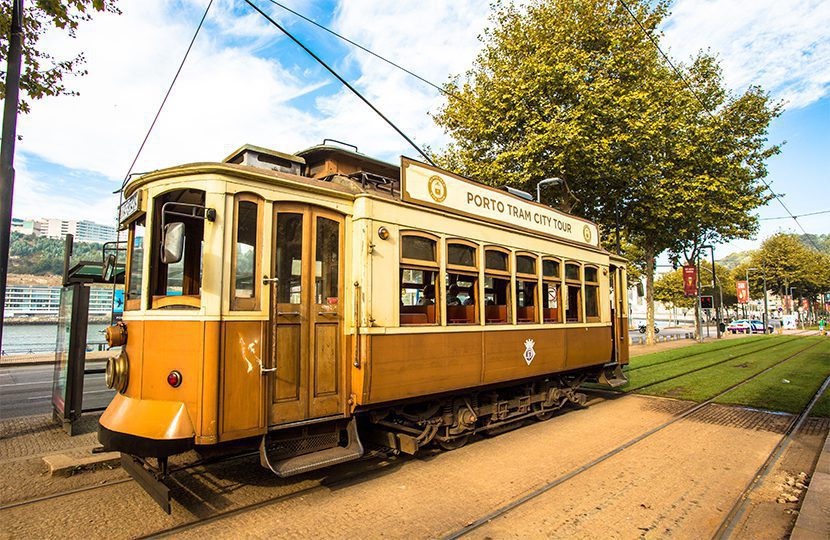
A vintage tramway that is still in service
Another selection in my gourmet findings, Postigo do Carvao is a small quaint pub-like restaurant with a traditional interior reminiscence of old Portugal Petisqueira (tapas) with exposed greyish and light brownstones and dark wood interior, bringing a romantic touch to the place. The staff is renowned for their friendly and attentive service while the overall mood is lively. Bands sometimes play in the main room, or some impromptu piano session by a dining guest can pop up.
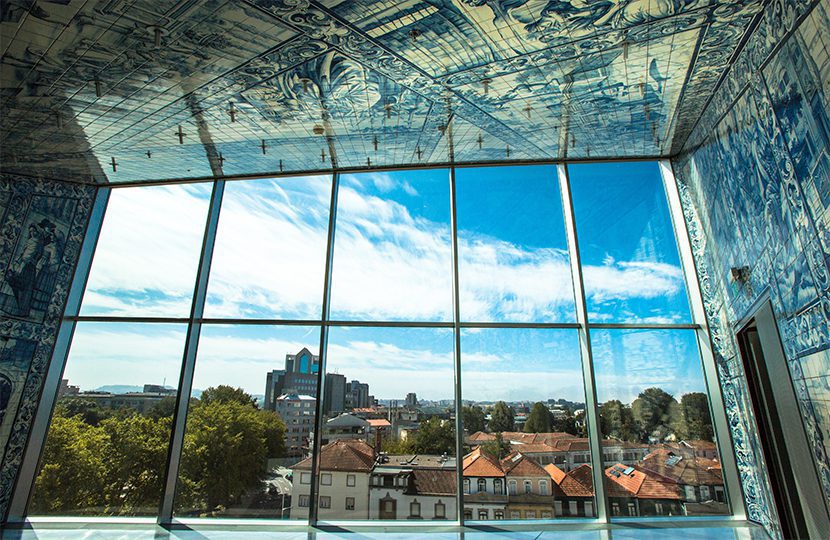
The large skylight at Casa da Musica VIP room
Highly recommended and for a big appetite, is the seafood stew with white beans paired with an excellent (and inexpensive) house wine (red or white). More adventurous connoisseurs should try the Tripas a Moda do Porto (tripe Porto style). www.facebook.com/postigodocarvao
After four days of epicurean delights, I decided to head to the wine area of Douro Valley and experience the lodge lifestyle in smaller villages along the Douro. I had taken Porto (or perhaps Porto had adopted me!) and added this delight of a coastal city to my list of potential retirement place to live under the blue skyline. From fourteenth-century Gothic churches, traditional eateries, dusty antique markets to fabulous beaches along Foz do Douro, dotted along by a plethora of restaurants, cafes and pubs, and two distinctive riversides with their distinguished flavours, Oporto is a beacon of Portuguese culture and spirit, all topped up with plenty of wine and of course, Porto!
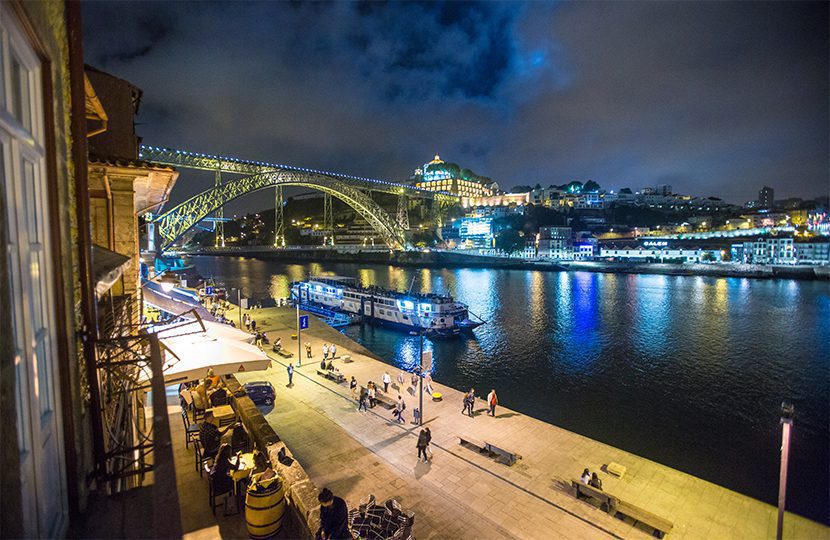
A beautiful night view over the Douro and the famous bridge Dom Luis in the backdrop

